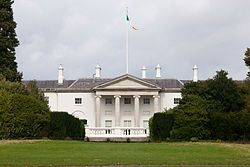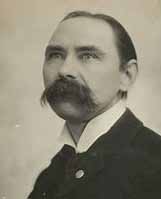Aras an Uachtarain (The President’s Residence), in the Phoenix Park, is one of city’s most attractive buildings and a favourite with both locals and tourists. It was designed by amateur architect and park ranger Nathaniel Clements in 1751 and completed in 1757. The building was bought by the British Crown in the 1780s as the summer residence of the Lord Lieutenant of Ireland, while his official residence was in the Viceregal Apartments in Dublin Castle. Soon the building became known as the Viceregal Lodge, which was occupied for most of the time from the 1820s onwards.
The road in front of the building, Chesterfield Avenue, is named after Philip Stanhope, 4th Earl of Chesterfield, who was appointed Lord Lieutenant in 1745. During his short tenure in Ireland he opened The Park to the public, made improvements on the property and erected the Phoenix monument.
During visits by Queen Victoria in the 1850s and 1860s she planted trees in the garden, and thus began the practice of guests planting a tree when they visited the president. This was carried on by Douglas Hyde, the first Irish President, and continues to this day.
It seems fairly obvious that the building is where the President should reside, but there was a time when other places were considered. In 1922 Glenstal Castle in Limerick, with its history of medieval Irish and English architecture, was a popular choice. However, due to the difficult economic position of the new state, and its distance from Dublin, it was decided to look elsewhere.
Apart from not considering the Aras as the President’s Residence, we are lucky to have the place at all. Eamon De Valera suggested that the building should be demolished to get rid of the colonial association, and replaced with something more suitable. However, the outbreak of World War II put an end to that plan, and by 1945 with the war over, the building had become very much associated with Douglas Hyde (from 1938) and the presidency.








